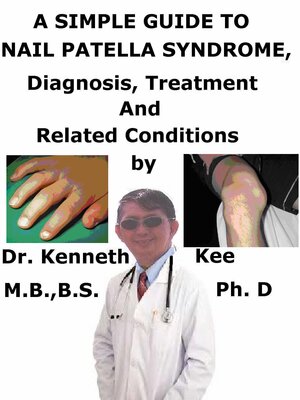A Simple Guide to Nail Patella Syndrome, Diagnosis, Treatment and Related Conditions
ebook
By Kenneth Kee

Sign up to save your library
With an OverDrive account, you can save your favorite libraries for at-a-glance information about availability. Find out more about OverDrive accounts.
Find this title in Libby, the library reading app by OverDrive.



Search for a digital library with this title
Title found at these libraries:
| Library Name | Distance |
|---|---|
| Loading... |
This book describes Nail Patella Syndrome, Diagnosis and Treatment and Related Diseases
Nail-Patella Syndrome (NPS) is a rare inherited disorder characterized by abnormalities of the nails, knees, elbows, and pelvis (tetrad of changes in the nails, knees, and elbows, and the presence of iliac horns).
Some affected people may have disorders in other areas of the body such as the kidneys and eyes.
The severity of the disorder and the linked signs and symptoms can differ significantly from person to person, even among members of the same family.
Nail-Patella Syndrome (Hereditary Onycho-Osteodysplasia) is caused by alterations (pathogenic variants or mutations) in the LMX1B gene and is inherited in an autosomal dominant manner.
Nail-Patella Syndrome is a rare inherited disorder with an estimated incidence of 1:50,000.
The beginning of symptoms may occur in the neonatal, infant, or childhood stage.
Both genders are equally affected.
The disorder may affect persons worldwide and occurs in all ethnic groups.
It is inherited in an autosomal dominant pattern which indicates that a person with the hereditary disorder has a 50% chance of passing it on to their children.
This gene is thought to produce protein that regulates other genes by "switching them on" during development.
Children, who do not inherit the abnormal gene, will not develop the disorder or pass it on to their offspring.
In autosomal dominant inheritance with variable expressivity, persons with the same genetic disorder demonstrate a wide range signs and symptoms.
While some may be asymptomatic or show only mild signs and symptoms, others may have life-threatening complications from the disorder.
It is thought that factors other than gene mutation, such as lifestyle and environment may add to the development of the disorder.
Almost every person with nail patella syndrome has abnormal nails, and many persons also have disorders with their patellae, elbows and pelvis.
Some of the disorders will be obvious from birth but others may not become apparent until later on.
The diagnostic tetrad involves fingernail dysplasia, absent or hypoplastic patellae, presence of posterior conical iliac horns, and deformation or luxation (i.e. hypoplasia) of the radial heads.
The medical presentations are extremely inconsistent in both incidence and severity, with interfamilial and intra-familial variability.
Kidney disease (focal segmental glomerulosclerosis) and glaucoma are now identified as part of the syndrome.
The most serious complication linked with nail-patella syndrome is nephropathy
Diagnosis of nail-patella syndrome involves a combination of medical evaluation, family history analysis, and imaging studies.
There is no curative treatment for nail patella syndrome.
Nail-patella syndrome is a lifelong disorder, and treatment is directed on managing specific symptoms and improving quality of life.
Medicines for high blood pressure and glaucoma
Braces and splints for abnormalities concerning the bones
Surgeries to correct bone abnormalities
Physical therapy
Dialysis for chronic kidney malfunction
Kidney transplantation for end-stage renal disease
Nail and skeletal abnormalities are normally stable throughout life, even though joint pain and limited mobility may produce discomfort.
Kidney involvement can range from mild proteinuria to more severe kidney disorder but not all persons with the syndrome develop kidney disorders.
With proper treatment, persons with nail-patella syndrome can lead fulfilling lives.
TABLE OF CONTENT







